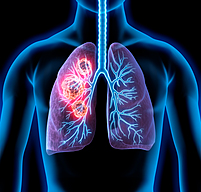Novel Particles as an Acute Lung Injury Therapeutic via Rapid Blocking of Neutrophil Migration in the Lungs
TECHNOLOGY NUMBER: 2019-409

OVERVIEW
Microparticles block neutrophil accumulation in the lungs of patients with acute lung injury or ARDS- The vascular-targeted particles achieve therapeutic benefit through physical interactions
- Rapid onset of action that is applicable to patients with active ALI/ARDS
BACKGROUND
Acute Lung Injury (ALI) is a progressive inflammatory disease characterized by the disruption of the lung endothelial and epithelial barriers causing airspace fluid accumulation, impaired gas exchange, and reduced lung function. In its most severe form, ALI leads to acute respiratory distress syndrome (ARDS) which can cause death in more than half of affected patients during their hospitalization or in the six months following discharge. The primary treatment for ALI/ARDS is to try to maintain oxygenation through mechanical ventilation or by the use of extracorporeal membrane oxygenation (ECMO).
Beyond supportive measures, pharmaceutical interventions for ALI/ARDS are limited. The inflammatory cascade that triggers ALI/ARDS leads to expression of leukocyte adhesion molecules (LAMS) which facilitate the rapid migration of circulating blood neutrophils. These neutrophils both destroy the alveolar-capillary barrier creating lung edema and accumulate in lung tissues to promote further damage to normal cells. The concentration of neutrophils in bronchoalveolar lavage fluid correlates with ARDS severity, so a need exists to foster research into methods for reducing the deleterious effects of neutrophils in this clinical setting.
INNOVATION
Researchers propose a novel approach that designs vascular-targeted nano- and micro-particles which can passively yet rapidly block neutrophil accumulation in inflamed lung tissues during acute lung injury and acute respiratory distress syndrome. The treatment has a rapid onset of action and can be effective even after the onset of ALI/ARDS. This invention does not require an active pharmaceutical ingredient (API), rather it builds upon published works which demonstrate that vascular-targeted particles (VTPs) in human blood interact with, and reduce vascular wall adhesion of, neutrophils to a monolayer of activated endothelial cells (ECs) in vitro.
These findings have been confirmed in a mouse model, with a greater than 90% drop in neutrophils recovered from bronchoalveolar lavage fluid in treated versus untreated mice. It is therefore the VTPs themselves that achieve therapeutic benefit solely through physical interactions rather than serving as carriers for a pharmaceutical agent. Neutrophil adhesion is prevented by both physical coverage of the EC surface as well as free stream particle-cell interactions. The VTPS are formed from a biodegradable, biocompatible PolyAspirin (PA) polymer which undergoes degradation to form salicylic acid. PA VTPs targeted to inflammation can block neutrophil migration into the lung airway in ALI, while also locally releasing salicylic acid, an anti-inflammatory agent, to further treat the lung injury. The discovery also holds hope for improving outcomes of other inflammatory conditions associated with neutrophil activation, such as sepsis.